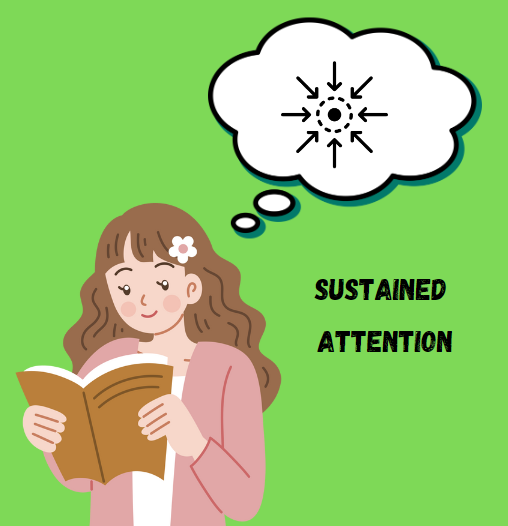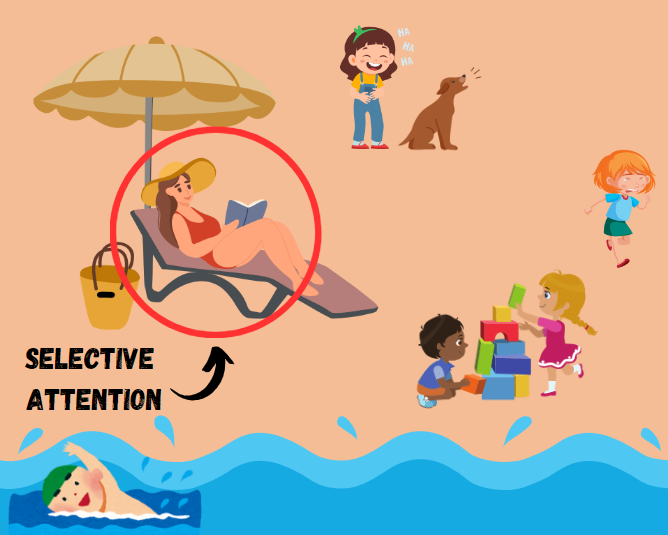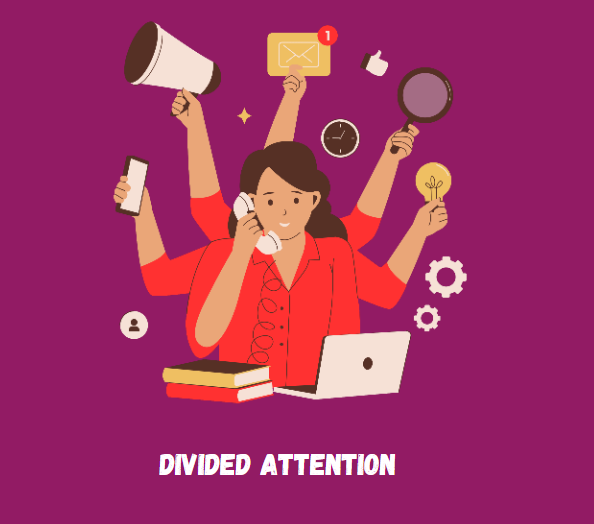Lately, I’ve been diving into the topic of ‘ATTENTION’ for one of my modules, and it’s super interesting. I thought you might find it cool too, so let’s check it out!
What is the nature of ATTENTION?
In our everyday lives, we can’t focus on everything happening around us. We end up picking and choosing what to pay attention to, often without even realizing it. So, attention is really about how we actively deal with the small bits of info we get from all the stuff happening around us.
Factors impact our ATTENTION
| INTERNAL FACTORS | EXTERNAL FACTORS |
|---|---|
| Interest | Intensity |
| Emotion | Size |
| Effort required by the task | Movement |
| Organic state | Novelty |
| Trains of thoughts | Changes |
| Color | |
| Contrast |
Types of ATTENTION
Sustained Attention
- This is the ability to focus on one specific task for a continuous period without being distracted.
- The level of sustained attention can vary.
- A key aspect of sustained attention is the ability to refocus on the task.
- Example : focusing for studying

Selective Attention

- This is the ability to select form the various factors or stimuli that are present and to focus on only the one that the person want.
- A person with good selective attention can avoid both internal and external distractions.
- Example: In this picture, so many activities are happening, but that lady is only focusing on that book.
Alternating Attention
- Ability of mental flexibility that allows a person to shift focus of attention and move between tasks that have different cognitive requirement; the different tasks may require the use of two different areas of a person brain.
- Example : Reading a recipe and performing the tasks of the recipe.

Divided Attention

- Ability to process two or more responses or react to two or more different demands simultaneously.
- Often referred to as multi – tasking.
- Example: Talking with someone over the phone while getting dressed.
- Human brain can only process one task at a time, ergo it is humanly impossible to concentrate on 2 different tasks at the same time.
- Muscle memory and/or habit is what help us successfully use divided attention.
Theories of SELECTIVE ATTENTION
Broadbent’s Bottleneck Theory
In 1958, a British psychologist named Donald Broadbent came up with the bottleneck theory. He said that our brains start filtering information as soon as we notice it with our senses, like when we see or hear something. There are many things happening around us, but Broadbent believed that our brain has a filter that picks out the most important things based on certain features. Only one piece of information gets through this filter and is fully processed so we can understand it. The other things we sense are filtered out early and don’t make it to our awareness.
Treisman’s Attention Model
Treisman’s attention model explains how our brain processes multiple streams of information at the same time, but only focuses on the most important one. This was shown through an experiment where participants listened to two different messages in each ear and were asked to repeat only one of them. Sometimes, participants accidentally said a word from the other message they weren’t supposed to be focusing on. Treisman believed this happened because the word made sense in the context of the message they were repeating. She suggested that our attention system has a filter that reduces, but doesn’t completely block, the importance of the other messages, allowing some information to slip through if it’s relevant.
Deutsch-Norman Late Selection Model
The Deutsch-Norman late selection model, developed by Deutsch and Deutsch in 1963 and later refined by Norman, suggests that our brain processes all incoming information for both its physical features and meaning before deciding what to focus on. This means that even information we aren’t actively paying attention to, like a conversation in the background, is still processed by our brain. For example, you might hear your name mentioned in a conversation you weren’t listening to. The model explains that our brain filters and selects information based on its importance, with the most relevant information being chosen for our attention just before we respond or act on it.
Instances of failure to pay ATTENTION
- Attentional deficit hyperactivity disorder (ADHD)
ADHD is a condition where people have trouble focusing on tasks, staying still, or controlling their impulses. This makes it hard for them to pay attention for long periods and can affect their daily life.
- Change blindness and inattentional blindness
These are situations where we fail to notice things around us. Change blindness happens when we don’t see a big change in our surroundings, like when an object suddenly disappears. Inattentional blindness occurs when we miss something obvious because we’re focused on something else, like not seeing a person walk by while we’re deep in thought.
- Spatial neglect
This is a condition often caused by brain damage where a person ignores one side of their environment. For example, someone with spatial neglect might eat food from only one side of their plate or not notice things on the left side of a room.
So I hope that by reading this, you’ve gained valuable insights into the fascinating world of attention.


Internet Chicks This was beautiful Admin. Thank you for your reflections.
Baddiehubs Nice post. I learn something totally new and challenging on websites
Your blog is a constant source of inspiration for me. Your passion for your subject matter is palpable, and it’s clear that you pour your heart and soul into every post. Keep up the incredible work!
Thank you ! Stay connected with us
Tech Learner This is really interesting, You’re a very skilled blogger. I’ve joined your feed and look forward to seeking more of your magnificent post. Also, I’ve shared your site in my social networks!
Thank you ! Stay connected with us
Noodlemagazine There’s clearly much to delve into regarding this subject. I value all the points you shared
gab Nice post. I learn something totally new and challenging on websites
This is the right bllog for anybody who wishes to find out about this
topic. You understand a whole lot its almost tough to argue with you (not that
I really would want to…HaHa). You cerrtainly put a fresh spin on a topic that’s been written about
for years. Wondeful stuff, just wonderful! https://WWW.Waste-Ndc.pro/community/profile/tressa79906983/
Very good info. Lucky me I came across your blog by accident
Very good info. Lucky me I came across your blog by accident
Hello everybody, here every person is sharing these kinds of experience,
so it’s fastidious to read this web site, and I used to visit this
webpage all the time.
Hello everybody, here every person is sharing these kinds of experience, so it’s fastidious to
read this web site, and I used to visit this webpage all
the time.
Hi to every body, it’s my first pay a quick visit of this weblog; this
webpage carries amazing and truly good stuff in support of visitors.
Hi to every body, it’s my first pay a quick visit of this weblog;
this webpage carries amazing and truly good stuff in support of visitors.
I’m really impressed together with your writing skills as well as with the layout on your weblog. Is that this a paid subject matter or did you customize it yourself? Anyway keep up the excellent quality writing, it’s rare to peer a great weblog like this one nowadays!
I want studying and I believe this website got some genuinely utilitarian stuff on it! .